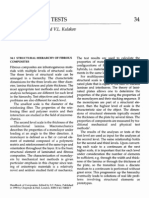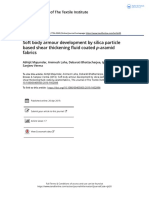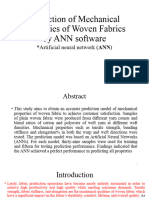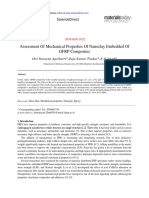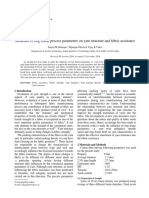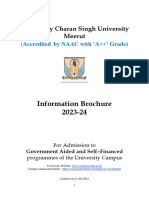Ballistic Behavior of Heracron - Based Co
Ballistic Behavior of Heracron - Based Co
Uploaded by
Pedro ThiagoOriginal Title
Copyright
Available Formats
Share this document
Did you find this document useful?
Is this content inappropriate?
Report this DocumentCopyright:
Available Formats
Ballistic Behavior of Heracron - Based Co
Ballistic Behavior of Heracron - Based Co
Uploaded by
Pedro ThiagoCopyright:
Available Formats
Modeling and Numerical Simulation of Material Science, 2013, 3, 84-89
http://dx.doi.org/10.4236/mnsms.2013.33011 Published Online July 2013 (http://www.scirp.org/journal/mnsms)
Ballistic Behavior of Heracron®-Based Composites: Effect
of the Number Multifilaments on High-Speed Projectiles
Jung Seop Lim
Samsung Electronics, Suwon, South Korea
Email: staach@dreamwiz.com
Received May 1, 2013; revised June 2, 2013; accepted June 10, 2013
Copyright © 2013 Jung Seop Lim. This is an open access article distributed under the Creative Commons Attribution License, which
permits unrestricted use, distribution, and reproduction in any medium, provided the original work is properly cited.
ABSTRACT
In this study, two Heracron® woven fabrics, HT840-1 and HT840-2, were fabricated with different multifilament fibers,
and their resistance to ballistic impact was investigated. For the same weight and number of plies, the HT840-2 fabric
showed improved ballistic properties, compared with HT840-1; this result is contrary to the fiber and fabric properties.
With the exception of the yarn’s physical properties, this behavior can be explained in terms of the number of multi-
filaments, which strongly influenced the ballistic mechanism, i.e., a greater number of multifilament fibers facilitates
energy dissipation from a high-speed ballistic projectile. In summary, establishing this optimal number of multifila-
ments is the key to optimizing the ballistic properties of any given fabric.
Keywords: Aramid Fiber; Ballistic Behavior; Heracron; Soft Armor
1. Introduction used in ballistic applications are usually plain and basket
weaves. Fabrics with unbalanced weaves typically yield
Aramid poly (p-phenylene terephthalamide) or PPTA
consists of relatively rigid polymer chains with linked inferior ballistic performance [8]. Lim et al. [9] investi-
benzene rings and amide bonds. This structure affords gated ballistic impacts on multiple systems to character-
aramid fibers high tenacity, high modulus, and toughness ize the reinforcement effect of multiple layers. They con-
[1-3]. Based on these merits, aramid fibers are used in cluded that the inter-ply friction inhibited the sideways
ballistic armor materials. Figure 1 shows the chemical motion of the yarns, resulting in an increased resistance
structure of aramid fibers. to ballistic penetration. Weave density, which refers to
Generally, ballistic materials can be divided into hard the number of yarns per unit dimension along the princi-
and soft armors [4-6]. Unlike traditional structural com- pal yarn directions, affects the areal density of the fabric
posites, hard armors, also known as armor-grade com- and the crimp. Shockey et al. [10] concluded that the
posites, contain only 20% by weight matrix, and are energy absorbed by a fabric was proportional to the fab-
made to readily delaminate. Conversely, soft armors ric’s areal density.
consist of multilayered, woven textiles, and are used to Our research group previously compared the effect of
protect against various types of bullets. the weaving density of aramid fabrics on their resistance
The ability of a woven fabric to protect against bullets to ballistic impacts. It was demonstrated that the exis-
depends primarily on the mechanical properties of the tence of an optimal weave minimizes damage to both the
yarn, such as the tenacity, tensile modulus, and toughness. yarn and fabric. Establishing these optimal conditions
However, Laible [7] demonstrated that “the relationship can be crucial in implementing better ballistic properties
between the mechanical properties of a yarn and the bal- into fabrics [11]. Yarn crimp refers to the degree of yarn
listic resistance of a plied fabric from such yarn has undulation, and is a property of the weave. Tan et al. [12]
never been established”; i.e., other factors may exist that compared two methods of modeling crimp using empiri-
influence ballistic performance. Generally, the energy cal results. They concluded that accounting for crimp by
absorption mechanism of soft armor depends on several modeling the linear elements in a zigzag manner yielded
additional factors, such as the weave pattern, the number more accurate results than trying to account for crimp as
of fabric plies, and the weave density. Weave patterns a constitutive property.
Copyright © 2013 SciRes. MNSMS
J. S. LIM 85
Table 1. Basic properties of two Heracron® yarns.
Property Young’s
Number of Tenacity Elongation
modulus
Sample multifilament (g/d) (%)
(g/d)
HT840-1 666 26.2 3.3 800
Figure 1. Chemical structure of aramid.
HT840-2 1000 25.9 3.2 804
However, little has been reported regarding correla-
tions between ballistic properties and multifilament ara-
sample was then wrapped twice around each grip. During
mid woven fabrics. Furthermore, a comparative study of
each test, the load frame crosshead moved at constant
ballistic performance has not been carried out that ac-
rate of 2 mm·s−1. Samples were pulled until rupture.
counts for both fabric properties and individual yarn
Twelve samples in total were tested. Six were elongated
properties. In the current study, two types of aramid
along the warp, with the weft running along the width.
woven fabrics, each with a different number of multi-
The other six were elongated along the weft, with the
filaments, were prepared, and the influences of the num-
warp running along the fabric width. Ballistic shooting
ber of multifilaments on the fabric properties and ballis-
tests were performed on 32-ply samples of each of the
tic behavior were ascertained. This study provides fun-
two fabrics (HT840-1 and HT840-2) in accordance with
damental information on how the number of multifila-
NIJ Standard-0101.06, “Ballistic Resistance of Body
ments regulates fabric properties and the ballistic behav-
Armor, Level 3A Methods”. Tests were performed with
ior of aramid woven fabrics.
44-Magnum semi-jacketed hollow-point (SJHP) bullets,
with a mass of 15.6 g (240 g) impacting the fabrics at a
2. Experimental Section
velocity of 436 ± 9 m·s−1 (1430 ± 30 ft·s−1). Six bullets
2.1. Materials were shot into each sample. After shooting, the depth of
the puncture and the back deformation signature (BFS)
Aramid fibers (trademark Heracron®) were produced by
formed on the backing material were measured. All tests
Kolon Inc. (Kwach’on, Korea) with a fiber fineness of
were conducted at the H.P. White Laboratory, Inc.
840 denier. Table 1 shows some of the basic properties
(Street, MD, USA).
of two Heracron® filament fibers, each composed of 666
and 1000 monofilament fibers, respectively. As shown in
Figure 1, the two Heracron® yarns had comparable te-
3. Results and Discussion
nacity, elongation, and Young’s modulus. Two types of 3.1. Fiber and Fabric Properties
fabrics, HT840-1 and HT840-2, were woven from the
Aramid fibers consist of highly oriented and ordered
fibers for ballistic tests. The two fabrics had the same
crystalline polymer chains, resulting in a rigid structure
weave structure, fiber fineness, and weaving density. The
that does not endure bending. Therefore, aramid yarn is
detailed fabric properties are described below. To elimi-
usually composed of one multifilament fiber, in conjunc-
nate finishing oil and surface contamination, the fabrics
tion with a large number of monofilament fibers. Gener-
were washed using an industrial scouring process.
ally, an aramid monofiber may be divided by its skin—
core fibril structure. It is known that the skin, in which
2.2. Analysis
the fibrils are uniformly axially oriented to the fiber axis,
Filament fiber tests were performed in accordance with strongly affects the fiber’s physical properties [1]. In
ASTM Standard D2256-97 (ASTM 2000). Each fiber contrast, fibril in the fiber core are imperfectly packed
specimen had an initial length of 50 cm. At the start of and ordered. Both the skin and core properties contribute
the test, the middle 25 cm of the fiber spanned between to the strength and resilience of the fiber. Therefore, it is
the instrument grips. The crosshead separation rate was important to comprehend the various properties of mono-
maintained at 2 mm·s−1, and the specimen was elongated filament fibers, as well as multifilament yarns. Table 2
until rupture. All of the specimens were twisted at a rate lists the properties of Heracron® monofilament fibers.
of 1.2 turns cm−1. The data from 20 independent meas- HT840-1, with a thicker monofilament fiber density, dis-
urements were expressed as an average with a single plays superior physical properties, compared with
standard deviation. Fabric tests were performed in ac- HT840-2. This suggests that the HT840-1 fiber is better
cordance with ISO 13934-1. All sample fabrics were suited for skin structure fabrication than that of HT840-2
created from the HT840 fabrics using the ravel strip during the dry-wet jet spinning process. Well oriented
method. Each sample had an initial length of 1.2 m and a skin fibril may prohibit the fiber rupture and improve its
width of 50 cm. A 50-mm length at each end of each physical property.
sample was clamped into place with a fabric grip. The Table 3 lists the physical properties of the extracted
Copyright © 2013 SciRes. MNSMS
86 J. S. LIM
Table 2. Physical properties of Heracron® monofilament HT840-2 along both the warp and weft directions. This
fiber. suggests that the fabric tensile strength may be strongly
Mono fiber Young’s influenced by the individual yarn’s physical properties.
Property Tenacity Elongation
Sample
density
(g/d) (%)
Modulus Hence, we anticipated that HT840-1 would efficiently
(De) (g/d) dissipate the energy from a high-speed ballistic projectile,
HT840-1 1.26 29.7 ± 0.5 3.8 ± 0.7 836 ± 12 resulting in better ballistic behavior compared with
HT840-2.
HT840-2 0.84 28.7 ± 0.6 3.5 ± 0.9 821 ± 16
3.2. Ballistic Properties
Table 3. Physical properties of extracted warp and weft
A comparison of ballistic properties can usually be made
yarns from Heracron® fabrics.
by analyzing crushed bullets retrieved from the tested
Property Young’s fabrics. An increase in the bullet crush may be due to a
Tenacity Elongation
modulus U*
Sample (g/d) (%)
(g/d)
better degree of energy propagation and dissipation by
the fabric, which would indicate superior ballistic per-
Warp 27.4 ± 0.4 3.7 ± 0.5 740 ± 13 820 ± 5
HT840-1 formance. Figure 2 shows a bottom view of crushed
Weft 30.4 ± 0.5 4.0 ± 0.3 760 ± 12 997 ± 7 bullets retrieved from the seventh ply of the HT840 fab-
rics. The bullet retrieved from HT840-2 was crushed to a
Warp 26.8 ± 0.6 3.5 ± 0.4 631 ± 11 700 ± 8
HT840-2 greater degree than the bullet retrieved from HT840-1,
Weft 27.5 ± 0.4 3.8 ± 0.4 601 ± 15 761 ± 9 demonstrating that HT840-2 had better energy absorption
capability. Note that this result is contrary to the fiber
warp and weft from the Heracron® fabrics. All of the and fabric mechanical results.
specimens were created by the ravel strip method and We compared the ballistic properties of the two
were pulled until rupture; 20 specimens were tested. Ir- HT840 fabrics by examining them directly. Figure 3
respective of warp and weft, HT840-1 had higher tenac- shows perforated regions in the HT840 fabrics (4-ply)
ity, elongation, and Young’s modulus, compared with impacted by the projectile. More yarn was broken and
HT840-2. This result supports the notion that the proper- fibrilized in the HT840-1 fabric, compared with HT840-2.
ties of the monofilament fiber are reflected in the proper- Moreover, the cross shape, without perforation, was still
ties of the multifilament yarn. The above data were used intact at the surface of the HT840-2 fabric. This demon
to calculate the dimensionless fiber property, U*, defined
as the product of the specific fiber toughness and the
strain-wave velocity, according to the follow equation:
E
U
2
where δ is the fiber ultimate tensile strength, ε is the fiber
ultimate tensile strain, E is Young’s modulus, and ρ is the
fiber density. U* can generally be used to qualitatively
(a) (b)
assess the physical performance of fibers. Note that the
U* value of HT840-2 was lower than that of HT840-1. Figure 2. A bottom view of the crushed bullets retrieved
Cunnif [11,13] demonstrated that U* may be a major from HT840 fabrics. (a) HT840-1; (b) HT840-2.
factor that relates ballistic impact performance to fiber
mechanical properties, independent of other parameters,
such as impacting projectile mass, presented area, or
areal density. Although the exact relationship between
the mechanical properties of a yarn and the ballistic re-
sistance of a plied fabric from such yarn has never been
established, the conclusion that the mechanical properties
of the yarn would affect a fabric’s ballistic characteristics
seems obvious.
Table 4 summarizes the physical properties of the
HT840-1 and HT840-2 fabrics. The thicknesses and areal (a) (b)
densities of the two fabrics were the same, but the fabric Figure 3. Perforated regions of two HT-840 fabrics impac-
tensile strength, generally considered the most important ted by the projectile (4-ply). (a) HT840-1 (4-ply); (b) HT840-
fabric property, differed; HT840-1 was stronger than 2 (4-ply).
Copyright © 2013 SciRes. MNSMS
J. S. LIM 87
strates that the HT840-1 fabric experienced more damage ficiently high velocity, the bullet will pass through the
from the high-speed projectile. Similar results are shown fabric. Relative to HT840-2, the pull-out zone of HT840-
in Figure 4, which displays the perforated regions in the 1 was clearly apparent. Additionally, a greater number of
HT840 fabrics (9-ply) impacted by the projectile. Very pulled-out yarns were observed along the bottom edge.
little damage (e.g., breakage and fibril) occurred in the The impact energy dissipates through yarn pullout, a
HT840-2 fabric, compared with HT840-1. consequence of yarn stretching. The pull-out zone is
Upon impaction by a projectile, fabrics generally fail cross-shaped, the center being the impact point [14]. The
through perforation mechanisms, which reflect both the high bullet resistance of a fabric is determined by the
energy absorption capability and ballistic performance of pulling-out of yarns impacted by the bullet. In these
the fabric. An increase in the number of broken yarns and zones, the bullet energy is transferred to the fibers. The
an appearance of perforated regions may indicate that the amount of energy transferred to the fabric layer in-
kinetic energy of the bullet could not be absorbed by the creases with the length and width of the pull-out zone as
fabric efficiently. The results reported herein show that the bullet decelerates. Based on this finding, we can
the kinetic energy of a bullet is more efficiently dissi- demonstrate that HT840-2 possesses a higher capacity
pated in the HT840-2 fabric, resulting in ballistic proper- for impact energy than HT840-1.
ties superior to those of HT840-1. Table 5 summarizes the ballistic properties of the two
Figure 5 shows a photograph of the ninth ply removed Heracron® woven fabrics. Generally, the deformation of
from each of the HT840 fabrics; the arrow indicates ballistic armor during impact can be assessed by meas-
yarns that were pulled from the fabric. When a woven uring the back deformation signature (BFS) [15]. The
fabric is subjected to a ballistic impact, it becomes de- BFS of HT840-1 was deeper than that of HT840-2, indi-
formed both vertically and horizontally by the kinetic cating that the kinetic energy of the bullet was not effi-
energy of the bullet. The initial deformation at the site of ciently dispersed over a large area of the fabric. The en-
impact spreads outward as long as the bullet’s speed is ergy absorption characteristics of a fabric system under
not sufficient to allow penetration of the fabric. Under ballistic impact depends on many factors, including the
these circumstances, the kinetic energy of the bullet will material properties of the constituent fibers, the woven
be completely absorbed by the fabric. However, at a suf-
(a) (b)
(a) (b)
Figure 5. Photograph of the ninth layer taken out of the two
Figure 4. Perforated regions of two HT-840 fabrics im- HT840 fabrics. (a) HT840-1 (9-ply); (b) HT840-2 (9-ply).
pacted by the projectile (9-ply). (a) HT840-1 (9-ply); (b)
HT840-2 (9-ply). Table 5. Ballistic property of Heracron® woven fabrics.
Table 4. Physical properties of Heracron® woven fabrics. AD BFS
Sample Bullet type ply
Sample (kg/m2) (mm)
HT840-1 HT840-2
Property
0.357 Sig. 32 6400 30/37/32
200 ± 1 200 ± 1 0.357 Sig. 32 6400 31/38/32
Areal density (g/m2) HT840-1
Warp 0.30 ± 0.05 0.30 ± 0.05 0.44 Mag. 32 6400 40/41/50
Thickness (mm)
Weaving density 105 ± 1 105 ± 1 0.44 Mag. 32 6400 40/42/51
(Treads/10cm)
Weft 105 ± 1 105 ± 1 0.357 Sig. 32 6400 29/33/32
0.357 Sig. 32 6400 28/31/33
Warp 8900 ± 500 8300 ± 500 HT840-2
Fabric tensile strength
0.44 Mag. 32 6400 37/39/37
(N/5cm)
Weft 8800 ± 500 8300 ± 500 0.44 Mag. 32 6400 38/40/36
Copyright © 2013 SciRes. MNSMS
88 J. S. LIM
structure of the fabric, the projectile geometry, the im- 1) The HT840-1 fiber and its fabric demonstrated higher
pact velocity, the number of plies, and the far-field values of tenacity, elongation, and Young’s modulus.
boundary conditions. In the current study, all of these However, the kinetic energy of a bullet was more ef-
parameters were held constant with the exception of both ficiently dissipated in the HT840-2 fabric, resulting in
yarn’s physical properties and multifilament fiber num- improved ballistic resistance properties, compared
ber. with those of HT840-1.
The physical properties of the HT840-1 fiber, i.e., its 2) The results given herein suggest that the lower ballis-
tenacity, elongation, and Young’s modulus, were supe- tic resistance of HT840-1 may be explained by an in-
rior to those of HT840-2. Therefore, we anticipated that sufficient number of multifilament fibers for accom-
the ballistic properties of HT840-1 would be superior to plishing the desired ballistic resistance.
HT840-2; however, this was not the case. Instead, our 3) Establishing this optimal number of multifilaments is
results suggested that better performance of the HT840-2 key to optimizing the ballistic properties of any given
fabric was achieved due to the multifilament fiber. Tradi- fabric.
tionally, better ballistic performance has been achieved
using greater numbers of multifilament fibers, which
REFERENCES
have been found to facilitate energy dissipation from
high-speed ballistic projectiles. Having a larger number [1] H. H. Yang and K. A. Fiber, “Aramid Fiber,” John Wiley
of multifilament fibers appears to provide better protec- & Sons Ltd., Chichester, 1993.
tion from high-speed rotating projectiles. The results [2] P. J. de Lang, P. G. Akker, E. Mäder, S. L. Gao, W. Pra-
given herein suggest that the lower ballistic resistance of sithphol and R. J. Young, “Controlled Interfacial Adhe-
sion of Twaron® Aramid Fibers in Composites by the Fin-
HT840-1 may be explained by an insufficient number of ish Formulation,” Composites Science and Technology,
multifilament fibers. Figure 6 shows the mimetic dia- Vol. 67, 2007, pp. 2027-2035.
grams of kinetic energy absorption and dispersion by the doi:10.1016/j.compscitech.2006.11.018
fabrics. [3] Y. Rao, A. J. Waddon and R. J. Farris, “The Evaluation
Of course, ballistic performance improvements have of Structure and Properties in Poly(p-phenylene tereph-
also been achieved through the use of high-performance thalamide) Fibers,” Polymer, Vol. 42, 2001, pp. 5925-
yarns that have been specifically engineered to have 5935.
higher tensile strengths and/or increased elongations be- [4] C. Y. Yue and K. Padmanabhan, “Interfacial Studies on
fore breakage. However, the combination of the yarn’s Surface Modified Kevlar Fibre/Epoxy Matrix Compo-
physical properties and other parameters must be care- sites,” Composite Part B, Vol. 30, No. 2, 1999, pp. 205-
217. doi:10.1016/S1359-8368(98)00053-5
fully investigated. In summary, establishing the optimal
number of multifilaments for a given fabric is one of the [5] T. K. Lin, S. J. Wu, J. S. Lai and S. S. Shyu, “The Effect
of Chemical Treatment on Reinforcement/Matrix Interac-
main factors influencing the ballistic resistance proper- tion in Kevlar-Fiber/Bismaleide Composites,” Compos-
ties of the fabric. ites Science and Technology, Vol. 60, No. 9, 2000, pp.
1873-1878. doi:10.1016/S0266-3538(00)00074-9
4. Conclusions [6] R. Park and J. S. Jang, “Impact Behavior of Aramid Fi-
®
Two Heracron woven fabrics with different numbers of ber/Glass Fiber Hybrid Composites: The Effect of Stak-
ing Sequence,” Colloid & Polymer, Vol. 22, No. 1, 2001,
multifilament fibers were assessed for their resistance to pp. 80-89.
ballistic impact. The results may be summarized as fol-
[7] R. C. Laible, “Fibrous Armor,” In: R. C. Laible, Ed., Bal-
lows: listic Materials and Penetration Mechanics, Elsevier Sci-
entific Publishing Co., New York, 1980, pp. 73-115.
doi:10.1016/B978-0-444-41928-6.50009-0
[8] P. M. Cunniff, “An Analysis of the System Effects in
Woven Fabrics under Ballistic Impact,” Textile Research
Journal, Vol. 62, No. 9, 1992, pp. 495-509.
(a) less mono filament
[9] C. T. Lim, V. B. C. Tan and C. H. Cheong, “Perforation
of High-Strength Double-Ply Fabric System by Varying
Shaped Projectiles,” International Journal of Impact En-
gineering, Vol. 27, No. 6, 2002, pp. 577-591.
doi:10.1016/S0734-743X(02)00004-0
[10] D. A. Shockey, D. C. Erlich and J. W. Simons, “Impro-
(b) more mono filament ved Barriers to Turbine Engine Fragments: Interim Re-
port III,” Report No. DOT/FAA/AR-99/8, 2004.
Figure 6. Mimetic diagrams of kinetic energy absorption and
dispersion by a fabric. [11] J. S. Lim, B. H. Lee, C. B. Lee and I. S. Han, “Effect of
Copyright © 2013 SciRes. MNSMS
J. S. LIM 89
the Weaving Density of Aramid Fabrics on Their Resis- San Antonio, 1999, pp. 1303-1310.
tance to Ballistic Impacts,” Engineering, Vol. 4, 2012, pp. [14] S. Bazhennov, “Dissipation of Energy by Bullet Proof
944-949. doi:10.4236/eng.2012.412A119 Aramid Fabric,” Journal of Materials Science, Vol. 32,
[12] V. C. Tan, V. P. W. Shim and X. Zeng, “Modeling Crimp No. 15, 1997, pp. 4167-4173.
in Woven Fabrics Subjected to Ballistic Impact,” Interna- doi:10.1023/A:1018674528993
tional Journal of Impact Engineering, Vol. 32, No. 1-4, [15] H. L. Gower, D. S. Cronin and A. Plumtree, “Ballistic
2005, pp. 561-574. doi:10.1016/j.ijimpeng.2005.06.008 Impact Response of Laminated Composite Panels,” Inter-
[13] P. M. Cunniff, “Dimensionless Parameters for Optimiza- national Journal of Impact Engineering, Vol. 35, No. 9,
tion of Textile-Based Body Armor Systems,” Proceed- 2008, pp. 1000-1008. doi:10.1016/j.ijimpeng.2007.07.007
ings of the 18th International Symposium on Ballistics,
Copyright © 2013 SciRes. MNSMS
You might also like
- Rabies: by Zakariya Al-NuaimiDocument16 pagesRabies: by Zakariya Al-Nuaimi123 sasNo ratings yet
- Kadirbilisik 2009Document13 pagesKadirbilisik 2009AvinashNo ratings yet
- 4.1.2 Fibre and Yarn PropertiesDocument2 pages4.1.2 Fibre and Yarn PropertiesLary LysuNo ratings yet
- Ali Karami 2016Document7 pagesAli Karami 2016Agripino FilhoNo ratings yet
- Composite StructuresDocument21 pagesComposite Structuresptlimaproject92No ratings yet
- VaT 2023 1 2Document12 pagesVaT 2023 1 2Mobarak HossainNo ratings yet
- Comparative Study of P-Aramid Based Soft and Stiff Composite Panels ForDocument7 pagesComparative Study of P-Aramid Based Soft and Stiff Composite Panels ForBhupendra Singh ButolaNo ratings yet
- Mechanical Tests: Yu.M. Tarnopol'skii and KulakovDocument16 pagesMechanical Tests: Yu.M. Tarnopol'skii and Kulakovsupriyo1970No ratings yet
- Energy Absorption of Three-Dimensional Braided Composites Under Impact Punch Shear LoadingDocument16 pagesEnergy Absorption of Three-Dimensional Braided Composites Under Impact Punch Shear LoadinghawNo ratings yet
- Ko Spider SilkDocument7 pagesKo Spider SilkAkash RsNo ratings yet
- Publication 1 - Article 2018Document13 pagesPublication 1 - Article 2018domaga03No ratings yet
- 7 2 12S AhmadDocument7 pages7 2 12S AhmadMehedi HasanNo ratings yet
- The Ballistic Impact Characteristics of Aramid Fabrics - Interface FrictionDocument19 pagesThe Ballistic Impact Characteristics of Aramid Fabrics - Interface FrictiongooogaNo ratings yet
- (2019) Soft Body Armour Development by Silica Particle Based Shear Thickening Fluid Coated P-Aramid FabricsDocument5 pages(2019) Soft Body Armour Development by Silica Particle Based Shear Thickening Fluid Coated P-Aramid FabricsJufri ArdiNo ratings yet
- Seam SlippageDocument9 pagesSeam SlippagesaidhawaryNo ratings yet
- Lecture 6Document24 pagesLecture 6Muhammad HassanNo ratings yet
- International Journal of Impact Engineering: E. Tapie, V.P.W. Shim, Y.B. GuoDocument12 pagesInternational Journal of Impact Engineering: E. Tapie, V.P.W. Shim, Y.B. GuoVeeturiVarunNo ratings yet
- Ballistic Impact of Dry Woven Fabric Composites: A Review: Ala Tabiei Gaurav NilakantanDocument13 pagesBallistic Impact of Dry Woven Fabric Composites: A Review: Ala Tabiei Gaurav NilakantanBhasker RamagiriNo ratings yet
- Finite Element Analysis of Pre-Stretch Effects On Ballistic Impact Performance of Woven FabricsDocument14 pagesFinite Element Analysis of Pre-Stretch Effects On Ballistic Impact Performance of Woven FabricsGuodong GuoNo ratings yet
- Camera Ready Paper 2Document9 pagesCamera Ready Paper 2Shri Narayan Agnihotri EPGDMAI Batch 1No ratings yet
- Experimental Dynamic Analysis of Laminated Composite BeamsDocument16 pagesExperimental Dynamic Analysis of Laminated Composite BeamssamikshaNo ratings yet
- Ijftr 39 (2) 122-129Document8 pagesIjftr 39 (2) 122-129Fashionnift NiftNo ratings yet
- 4.1.3 Effects of Fabric FinishingDocument4 pages4.1.3 Effects of Fabric FinishingLary LysuNo ratings yet
- Properties of Spider SilkDocument9 pagesProperties of Spider SilkArifah PujiatiNo ratings yet
- Short Fiber Reinforced Composite The Effect of Fiber Length and Volume FractionDocument10 pagesShort Fiber Reinforced Composite The Effect of Fiber Length and Volume FractionMiranti AuliaNo ratings yet
- Effects of Fabric Folding and Thickness On The ImpDocument16 pagesEffects of Fabric Folding and Thickness On The ImpJovana StojkovićNo ratings yet
- Fabric Science-Ii: Assignment-3Document5 pagesFabric Science-Ii: Assignment-3nikitaNo ratings yet
- Influence of Weave Design and Yarn Types On Mechanical and Surface Properties of Woven FabricDocument4 pagesInfluence of Weave Design and Yarn Types On Mechanical and Surface Properties of Woven FabricChinedu ObasiNo ratings yet
- Effects of Fabric Construction and Shear Thickening Fluid On Yarn Pull-Out From High-Performance FabricsDocument11 pagesEffects of Fabric Construction and Shear Thickening Fluid On Yarn Pull-Out From High-Performance FabricshawNo ratings yet
- Investigation of Load Transfer Between The Fiber and The Matrix in Pull-Out Tests With Fibers Having Different DiametersDocument32 pagesInvestigation of Load Transfer Between The Fiber and The Matrix in Pull-Out Tests With Fibers Having Different DiametersKrovvidi Parthasaradhi me18m045No ratings yet
- Studies On Elastane-Cotton Core-Spun Stretch Yarns and Fabrics: Part I Yarn CharacteristicsDocument7 pagesStudies On Elastane-Cotton Core-Spun Stretch Yarns and Fabrics: Part I Yarn CharacteristicsMitu ChowdhuryNo ratings yet
- Magnetorheological Fluids As A Prospective Component of Composite ArmoursDocument5 pagesMagnetorheological Fluids As A Prospective Component of Composite ArmoursSuwerenNo ratings yet
- Study On The Tearing Behaviour of Woven ShirtDocument11 pagesStudy On The Tearing Behaviour of Woven ShirtishanhbmehtaNo ratings yet
- Composites Communications: Mukesh Bajya, Abhijit Majumdar, Bhupendra Singh ButolaDocument5 pagesComposites Communications: Mukesh Bajya, Abhijit Majumdar, Bhupendra Singh Butolaptlimaproject92No ratings yet
- 1993 - Study of The Interface in Kevlar 49 Epoxy Composites by Means of Microbond and Fragmentation Tests Effects of Materials and Testing VariablesDocument7 pages1993 - Study of The Interface in Kevlar 49 Epoxy Composites by Means of Microbond and Fragmentation Tests Effects of Materials and Testing VariablesRushi TutorNo ratings yet
- Computational Analysis of Impact of A Bullet Against The Multilayer Fabrics in LS-DYNADocument20 pagesComputational Analysis of Impact of A Bullet Against The Multilayer Fabrics in LS-DYNAPunith MlNo ratings yet
- Effect of Loading Behaviour On Compressional Property of Needle-Punched Nonwoven FabricDocument9 pagesEffect of Loading Behaviour On Compressional Property of Needle-Punched Nonwoven Fabricsasi kumar UNo ratings yet
- Ijftr 43 (2) 164-172Document9 pagesIjftr 43 (2) 164-172anil beniwalNo ratings yet
- The Effect of Weave Construction On Tear Strength of Woven FabricsDocument8 pagesThe Effect of Weave Construction On Tear Strength of Woven FabricsSuza Ahmed AuporboNo ratings yet
- National Textile University: B.Sc. Textile Engineering Practical Lab Report / Fall-2018Document5 pagesNational Textile University: B.Sc. Textile Engineering Practical Lab Report / Fall-2018Faisal SaeedNo ratings yet
- Finite Element (FE) Shear Modeling of Woven Fabric Textile CompositeDocument7 pagesFinite Element (FE) Shear Modeling of Woven Fabric Textile Compositeranim najibNo ratings yet
- 33 PDFDocument6 pages33 PDFMd. Humayun KabirNo ratings yet
- Eproxy Graphite FibersDocument5 pagesEproxy Graphite FibersJournalNX - a Multidisciplinary Peer Reviewed JournalNo ratings yet
- Influence of Polyester Fibre Shape and SDocument9 pagesInfluence of Polyester Fibre Shape and SKRISTINE MAE TAMAYONo ratings yet
- GangLi - Impact Modelling of Kevlar Fabric Composite PanelsDocument20 pagesGangLi - Impact Modelling of Kevlar Fabric Composite PanelsRafael ZanettiNo ratings yet
- Relationship Scale Effect and Structure Levels in Fibrous StructuresDocument9 pagesRelationship Scale Effect and Structure Levels in Fibrous Structuresapi-3733260No ratings yet
- Polymer Composites Reinforced With Hybrid Fiber FabricsDocument13 pagesPolymer Composites Reinforced With Hybrid Fiber FabricsRodrigo Lara MarrugoNo ratings yet
- Bamboo Acrylic TapeDocument15 pagesBamboo Acrylic TapePUSPHAREKA SNo ratings yet
- Ijer 2014 106 PDFDocument5 pagesIjer 2014 106 PDFCva RajNo ratings yet
- Corbin 2018 IOP Conf. Ser. Mater. Sci. Eng. 406 012016Document12 pagesCorbin 2018 IOP Conf. Ser. Mater. Sci. Eng. 406 012016adonaies19No ratings yet
- 59 22 84 PDFDocument4 pages59 22 84 PDFhawNo ratings yet
- Studies On Tensile Properties of Eri/acrylic Blended Yarn: Prabir Kumar Choudhuri, Prabal Kumar Majumdar & Bijon SarkarDocument8 pagesStudies On Tensile Properties of Eri/acrylic Blended Yarn: Prabir Kumar Choudhuri, Prabal Kumar Majumdar & Bijon SarkarMax SmokeNo ratings yet
- Shaikat-Tex 2Document10 pagesShaikat-Tex 2shaikat6163No ratings yet
- 1 s2.0 S0266353811004131 MainDocument10 pages1 s2.0 S0266353811004131 Mainjaqueline.fgontijooNo ratings yet
- Warp KnittingDocument14 pagesWarp KnittingkbalabalaNo ratings yet
- Theoretical Determination of The Optimal Fiber Volume Fraction and Fiber-Matrix Property Compatibility of Short Fiber CompositesDocument9 pagesTheoretical Determination of The Optimal Fiber Volume Fraction and Fiber-Matrix Property Compatibility of Short Fiber Compositesapi-3733260No ratings yet
- Essential Properties of Fibres For Composite ApplicationsDocument36 pagesEssential Properties of Fibres For Composite Applicationsgabao123No ratings yet
- Biomimetic Principles and Design of Advanced Engineering MaterialsFrom EverandBiomimetic Principles and Design of Advanced Engineering MaterialsNo ratings yet
- The Mechanical Properties of Wood: Including a Discussion of the Factors Affecting the Mechanical Properties, and Methods of Timber TestingFrom EverandThe Mechanical Properties of Wood: Including a Discussion of the Factors Affecting the Mechanical Properties, and Methods of Timber TestingNo ratings yet
- Protein Fibre Surface Modification: Jolon Dyer and Anita GrosvenorDocument16 pagesProtein Fibre Surface Modification: Jolon Dyer and Anita GrosvenorIsabelaNo ratings yet
- Result - 1hDocument1 pageResult - 1hPriyanshu ChauhanNo ratings yet
- Bilar Man-Made ForestDocument1 pageBilar Man-Made Forestu corgiiNo ratings yet
- 1583214542Document386 pages1583214542saulomon100% (1)
- Campus Brochure New 2023 24Document122 pagesCampus Brochure New 2023 24NkNo ratings yet
- MIDTERM Questioned DocumentDocument8 pagesMIDTERM Questioned DocumentJerine Alba Pueblo100% (1)
- Cars (Pumarada)Document10 pagesCars (Pumarada)RocelynNo ratings yet
- Using A Mini Triple Point of Water System To Improve Reliability in A Temperature Cal LabDocument8 pagesUsing A Mini Triple Point of Water System To Improve Reliability in A Temperature Cal LabStudent ForeignNo ratings yet
- Performance Characteristics of A CoconutDocument14 pagesPerformance Characteristics of A CoconutNeil TaneoNo ratings yet
- LittelFuse FuseSelectionDocument9 pagesLittelFuse FuseSelectionRodrigo Aguilar VillasecaNo ratings yet
- Supply and Demand Day Trading Using Price Action and Top Down AnalysisDocument24 pagesSupply and Demand Day Trading Using Price Action and Top Down AnalysisKevin Mwaura100% (2)
- DEB08003FU1Document9 pagesDEB08003FU1IkaNo ratings yet
- Spherical Bearings CalculationsDocument2 pagesSpherical Bearings CalculationsPallab GhoshNo ratings yet
- Dune Imperium Uprising RulebookDocument20 pagesDune Imperium Uprising Rulebookremy.auricoste100% (1)
- One Percent BetterDocument81 pagesOne Percent BetterKarlo Krpan100% (1)
- M. Fabrizio: Michele - Fabrizio@ssdc - Asi.itDocument23 pagesM. Fabrizio: Michele - Fabrizio@ssdc - Asi.itmicheleNo ratings yet
- My Perspectives 3Document17 pagesMy Perspectives 3Karolina WiniarskaNo ratings yet
- SGC-Resolution-3 LSBDocument2 pagesSGC-Resolution-3 LSBEmerson GalanoNo ratings yet
- EMS Internal Audit GuidanceDocument3 pagesEMS Internal Audit GuidanceVelraj ParthibanNo ratings yet
- Lecture 2 Summer - Three Phase DiagramsDocument31 pagesLecture 2 Summer - Three Phase DiagramsLogan Patrick100% (1)
- Star Trek RPG LUG25000 - Next Generation Sheets & TemplatesDocument6 pagesStar Trek RPG LUG25000 - Next Generation Sheets & TemplatesTonyNo ratings yet
- A Review On Analysis of EEG Signals PDFDocument4 pagesA Review On Analysis of EEG Signals PDFdaytdeenNo ratings yet
- Soal PAT II Bhs Inggris Kelas VIIDocument5 pagesSoal PAT II Bhs Inggris Kelas VIIevelyne serafeeNo ratings yet
- Electric Charges & Fields Assignment-2Document3 pagesElectric Charges & Fields Assignment-2riddhimaNo ratings yet
- STD Iv CT4 Portions and Time TableDocument5 pagesSTD Iv CT4 Portions and Time TableS sangeethaNo ratings yet
- Grad Student Kolblab MarburgDocument1 pageGrad Student Kolblab Marburgfiw ahimNo ratings yet
- Đề Thi Thử TN THPT 2021 - Môn Tiếng Anh - THPT Quế Võ 1 - Bắc Ninh - Lần 1 - File Word Có Lời GiảiDocument14 pagesĐề Thi Thử TN THPT 2021 - Môn Tiếng Anh - THPT Quế Võ 1 - Bắc Ninh - Lần 1 - File Word Có Lời GiảiHuyền KhánhNo ratings yet
- Humanoid Robots SeminarDocument28 pagesHumanoid Robots SeminarMan HunNo ratings yet
- UTL700 Resources For Wastewater TreatmentDocument4 pagesUTL700 Resources For Wastewater Treatmentmika cabelloNo ratings yet







